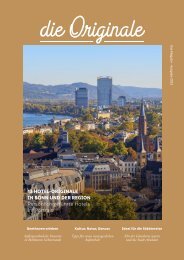LUXAIR_LUXiClub_So12 ls
p o
p
o
Create successful ePaper yourself
Turn your PDF publications into a flip-book with our unique Google optimized e-Paper software.
Number 43, Fall 2002
cartographic perspectives
Line 7. “Bale”: Old English bealu, “evil,” “destructive”
Line 8. “Breast-hoard”: Old English breosthord, “thoughts”; i.e., “the
memory of loved ones” (Birney 1972, 85)
Line 9. “Cetegrande”: Old French cete grande, “great whale”
Line 11. “Hight”: Old English haten, “called,” “named”
Line 12. “Redeless”: Old English raedleas, “resourceless,” “helpless”
Line 14. “Adread”: Old English ofdraedd, “frightened,” “terrified”
In 1945, Earle Birney was on his way home. A major in the Canadian
Army during World War II, Birney had contracted diphtheria while on
duty in Europe. After treatment in an English military hospital, he was
awaiting his return on the hospital ship El Nil, when he overheard Canadian
soldiers and their English girlfriends pledge eternal love. Wondering
how many promises would be broken by distance and time, Birney
composed “Mappemounde” as he sailed west over the Atlantic. About a
seafarer’s ill-fated struggle to cross the ocean of medieval world maps,
“Mappemounde” laments the ephemerality of love, fidelity, and life itself
(Birney 1972, 86; Aichinger 1979, 76-78).
Birney would later credit World War II with making him a poet (Davey
1971, 20-21). He received his first prestigious Governor General’s Award
for poetry in 1942. The second came in 1945, the year he wrote “Mappemounde.”
Three years later, Birney placed the poem immediately after the
one opening his third collection of poetry, The Strait of Anian (Birney 1948,
4). Since then, “Mappemounde” has been heavily anthologized. Acknowledging
its importance, Birney included revised versions in his Selected
Poems 1940-1966 (Birney 1966, 90), Ghost in the Wheels (Birney 1977b, 34),
and the Collected Poems of Earle Birney, from which our text derives. 2 (The
Collected Poems of Earle Birney by Earle Birney, 2 vols., Toronto: McClelland
and Stewart, 1975, 1:92. Courtesy of Wailan Low, executor of the estate of
Earle Birney.)
The poem’s charm, as well as its difficulty, has its origin in Old English
(c.450-c.1100) and Middle English (c.1100-c.1500). An academic as well as
a poet, Birney had received his doctorate in English from the University of
Toronto in 1936 and taught there before serving overseas. After the war, he
went on to teach medieval literature and creative writing at the University
of British Columbia (1946-1965). There, he regularly offered courses on Old
English and Geoffrey Chaucer, who was the subject of both his dissertation
and a book of essays on irony (Birney 1985). Birney was so adept at medieval
English “that he often quipped in phrases or lines from early literary
works” (Cameron 1994, 380, and 352).
As the words appended to the poem attest, “Mappemounde” abounds
in the Anglo-Saxon and Viking-borne Norse vocabulary of Old English.
The noun nadder (“serpent”) may be as obsolete as the adjectives redeless
(“helpless”) and adread (“fearful”). But the names of the cardinal directions,
the adverbial suffix “-ward,” and the strong, monosyllabic verbs
“suck,” “hem,” “tread,” and “drift” all betray the Germanic roots of
Modern English. “Mappemounde” also mimics the Old English use of
vivid metaphorical compounds, called kennings, to replace simple nouns:
“gleeword” (gliwword, “entertaining-word”) rather than “song,” “breasthoard”
instead of “thoughts.” For the Anglo-Saxon scop (“bard”), kennings
displayed poetic talent and aided the oral transmission of verse. Birney
imitated their bardic practice. By combining words derived from Old English,
he created “whalehall” (hwael + heall) along with its wealth of associations
no longer obvious in the more prosaic “sea.”
Also reminiscent of Old English verse are the poem’s alliteration and
rhythmic pattern. Accents and italics help us visualize how the second line
“About a seafarer’s ill-fated
struggle to cross the ocean of
medieval world maps,
“Mappemounde” laments the
ephemerality of love, fidelity,
and life itself.”
“As the words appended to the
poem attest, “Mappemounde”
abounds in the Anglo-Saxon
and Viking-borne Norse
vocabulary of Old English.”















